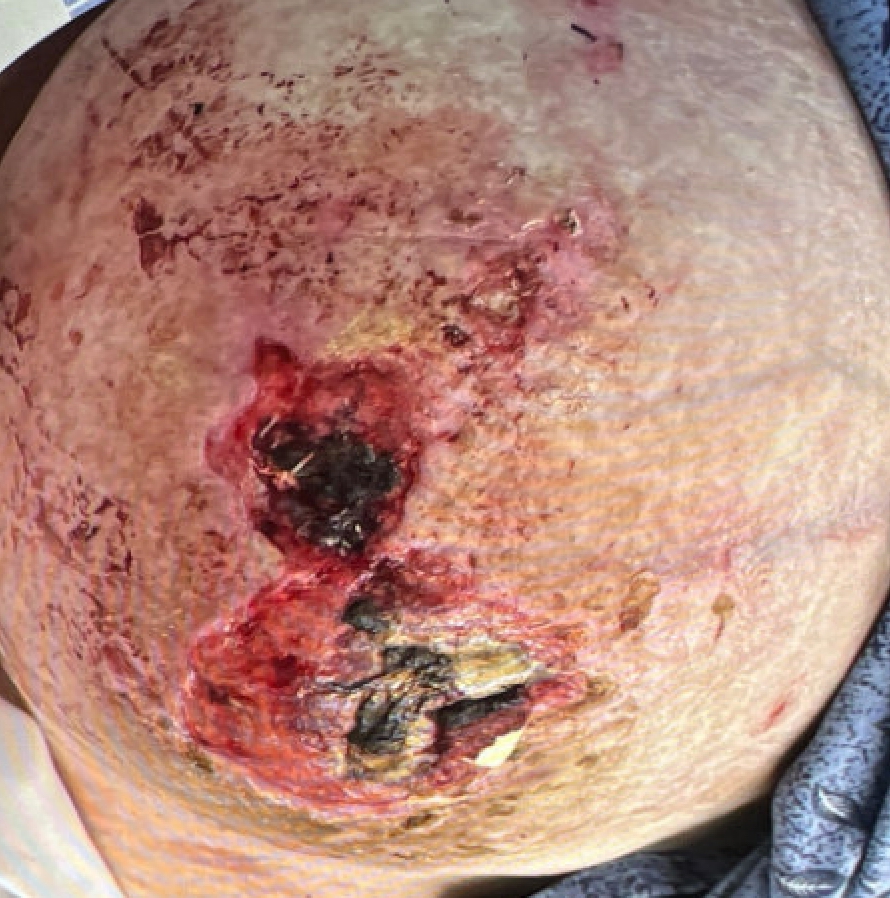Tuesday Poster Session
Category: Liver
P6025 - A Rare Case of Flood Syndrome Involving a Ventral Incisional Hernia in a Patient With Newly Diagnosed Cirrhosis
Tuesday, October 28, 2025
10:30 AM - 4:00 PM PDT
Location: Exhibit Hall

Claire Faulkner, MD, MPH (she/her/hers)
Boston Medical Center
Boston, MA
Presenting Author(s)
Claire Faulkner, MD, MPH1, Rosa L. Yu, MD1, Laura Chiu, MD, MPH2
1Boston Medical Center, Boston, MA; 2Boston University, Boston, MA
Introduction: Flood syndrome is a rare complication of cirrhosis characterized by spontaneous rupture of an umbilical hernia with resulting leakage of ascitic fluid. We present a unique case of Flood syndrome involving a ventral incisional hernia in a patient with newly diagnosed cirrhosis.
Case Description/
Methods: A 71-year-old male with obesity and a history of diverticulitis status post sigmoidectomy complicated by a longstanding ventral incisional hernia presented to the emergency room with acute bleeding from a chronic wound overlying his hernia. He was found to be distended (Figure 1) and clinically concerning for having intra-abdominal hemorrhage. He underwent exploratory laparotomy, which noted an incarcerated ventral hernia, bleeding abdominal varices, and an 8 × 6 cm area of ulcerated, necrotic tissue overlying the hernia. The tissue was excised and varices were ligated prior to mesh repair. Twelve liters of hemorrhagic ascites were drained. Ascitic fluid studies were consistent with portal hypertension, with a serum ascitic albumin gradient of 2.2 g/dL and ascitic protein of 1.5 g/dL. The Hepatology service was consulted as the patient had no known history of liver disease. Ultimately, his cirrhosis was thought to be secondary to MASLD and prior alcohol use. He continued to have significant ascites, for which a transjugular intrahepatic portosystemic shunt (TIPS) was performed and diuretics were initiated. He was discharged with improvement in ascites and no evidence of hepatic encephalopathy.
Discussion: This case of a ruptured ventral incisional hernia represents an uncommon presentation of Flood syndrome, typically linked with spontaneous umbilical hernia rupture in decompensated cirrhosis. It challenges the assumption that Flood syndrome is limited to umbilical hernias and emphasizes the need to consider other abdominal wall defects as high-risk rupture sites. As the population ages, more patients accumulate hernia risk factors, such as prior abdominal surgeries and obesity, contributing to an increase in hernia incidence. This case underscores the need to reassess the anatomical boundaries of Flood syndrome and adopt a more inclusive approach towards identifying and managing rupture sites. Although no standardized treatment for Flood Syndrome exists, prompt recognition is critical. Herniorrhaphy and TIPS have been described as effective management strategies.

Figure: Figure 1. Distended abdomen with large ventral incisional hernia with overlying ulcerated wound.
Disclosures:
Claire Faulkner indicated no relevant financial relationships.
Rosa Yu indicated no relevant financial relationships.
Laura Chiu indicated no relevant financial relationships.
Claire Faulkner, MD, MPH1, Rosa L. Yu, MD1, Laura Chiu, MD, MPH2. P6025 - A Rare Case of Flood Syndrome Involving a Ventral Incisional Hernia in a Patient With Newly Diagnosed Cirrhosis, ACG 2025 Annual Scientific Meeting Abstracts. Phoenix, AZ: American College of Gastroenterology.
1Boston Medical Center, Boston, MA; 2Boston University, Boston, MA
Introduction: Flood syndrome is a rare complication of cirrhosis characterized by spontaneous rupture of an umbilical hernia with resulting leakage of ascitic fluid. We present a unique case of Flood syndrome involving a ventral incisional hernia in a patient with newly diagnosed cirrhosis.
Case Description/
Methods: A 71-year-old male with obesity and a history of diverticulitis status post sigmoidectomy complicated by a longstanding ventral incisional hernia presented to the emergency room with acute bleeding from a chronic wound overlying his hernia. He was found to be distended (Figure 1) and clinically concerning for having intra-abdominal hemorrhage. He underwent exploratory laparotomy, which noted an incarcerated ventral hernia, bleeding abdominal varices, and an 8 × 6 cm area of ulcerated, necrotic tissue overlying the hernia. The tissue was excised and varices were ligated prior to mesh repair. Twelve liters of hemorrhagic ascites were drained. Ascitic fluid studies were consistent with portal hypertension, with a serum ascitic albumin gradient of 2.2 g/dL and ascitic protein of 1.5 g/dL. The Hepatology service was consulted as the patient had no known history of liver disease. Ultimately, his cirrhosis was thought to be secondary to MASLD and prior alcohol use. He continued to have significant ascites, for which a transjugular intrahepatic portosystemic shunt (TIPS) was performed and diuretics were initiated. He was discharged with improvement in ascites and no evidence of hepatic encephalopathy.
Discussion: This case of a ruptured ventral incisional hernia represents an uncommon presentation of Flood syndrome, typically linked with spontaneous umbilical hernia rupture in decompensated cirrhosis. It challenges the assumption that Flood syndrome is limited to umbilical hernias and emphasizes the need to consider other abdominal wall defects as high-risk rupture sites. As the population ages, more patients accumulate hernia risk factors, such as prior abdominal surgeries and obesity, contributing to an increase in hernia incidence. This case underscores the need to reassess the anatomical boundaries of Flood syndrome and adopt a more inclusive approach towards identifying and managing rupture sites. Although no standardized treatment for Flood Syndrome exists, prompt recognition is critical. Herniorrhaphy and TIPS have been described as effective management strategies.

Figure: Figure 1. Distended abdomen with large ventral incisional hernia with overlying ulcerated wound.
Disclosures:
Claire Faulkner indicated no relevant financial relationships.
Rosa Yu indicated no relevant financial relationships.
Laura Chiu indicated no relevant financial relationships.
Claire Faulkner, MD, MPH1, Rosa L. Yu, MD1, Laura Chiu, MD, MPH2. P6025 - A Rare Case of Flood Syndrome Involving a Ventral Incisional Hernia in a Patient With Newly Diagnosed Cirrhosis, ACG 2025 Annual Scientific Meeting Abstracts. Phoenix, AZ: American College of Gastroenterology.
